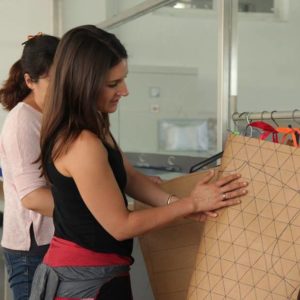Excuse the stereotypes for this one, please:
Lots of girls grow up wanting to design clothes. Like boys and their dreams of becoming professional athletes, most of those
girls end up doing something more humble and ordinary. Of those who do enter the fashion industry, few actually design clothes.
Meet the exception to the rule: Cheri Sanguinetti, 33, apparel director for Cotopaxi and designer of the Bengal and Kusa jackets (better known in these parts at the Perfect Barn Coat and the Perfect Layer).
Sanguinetti grew up on a ranch west of San Francisco. Her first job out of college was in the western and equestrian boot division of Ariat. Since then, she’s worked for Marmot, Nike, and Columbia Sportswear, among others.
When she joined Cotopaxi as apparel director and founding team member in 2013, she was excited and ready.
“I’m an entrepreneur at heart. Self-starters are in my blood,” said Sanguinetti from the Cotopaxi offices in Salt Lake City, Utah. “To be apparel director here gave me the chance to really infuse the brand and not just go with the flow. That was a huge draw.”
Sanguinetti was a great fit for CEO Davis Smith’s vision of Cotopaxi:
“Cheri comes from the outdoor industry, but if you take one look at her you know she understands fashion,” said Smith. “The outdoor world is infamous for designing for men, and then shrinking and pinking the products to try to cater to a female consumer. Cheri’s vision for our apparel line has been refreshing, innovative and forward thinking. Her fashion sense is exactly what the outdoor industry has needed.”
The Bengals’ rustic yet refined look is due, not just to the styling, but also to the choice of fabrics and use of technology, explained Sanguinetti. She used Polartec Alpha insulation and lightly waxed canvas. “It breathes, so you don’t have to take it on and off. Maybe my farm upbringing sneaks into its styling. My niece does high school rodeo and she loves it.”
As for the Kusa, it was her idea to use llama fiber. It might seem like a no brainer, given that the company’s logo is a llama silhouette and two llamas (Coto and Paxi) routinely hang out and schmooze at Cotopaxi events. But the task proved challenging. Fine llama fibers are difficult to source. The Kusa uses product from Bolivian farms.
Sanguinetti likes that it’s more sustainable (and humane) than goose down. It doesn’t poke through like feathers do and performs better than wool, she said.
Keep up the good work, Cheri!
Check out the Kusa review here and the Bengal review here. Enter “nickernews” at checkout to receive 20 percent off.

